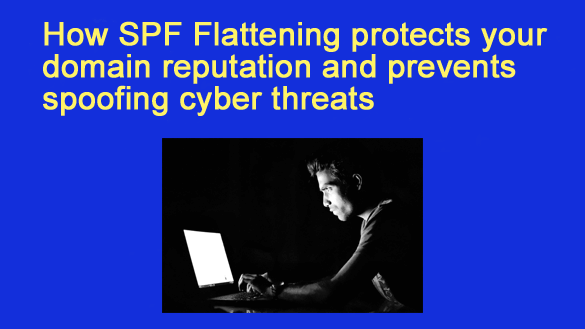 The Sender Policy Framework (SPF) is essential for email verification, as it determines which mail servers have permission to send emails for your domain.
The Sender Policy Framework (SPF) is essential for email verification, as it determines which mail servers have permission to send emails for your domain.
However, when companies utilize various third-party services such as customer relationship management systems, marketing applications, or cloud solutions, their SPF records can grow excessively long and surpass DNS lookup limitations. This can result in authentication failures that not only hinder email delivery but also expose your domain to potential misuse by cybercriminals aiming to execute spoofing attacks.
SPF flattening addresses this issue by substituting intricate “include” statements with straightforward IP addresses, which keeps the record within necessary limits while ensuring consistent validation. By upholding a robust SPF record, flattening aids organizations in safeguarding their domain reputation, preventing spoofed emails, and enhancing inbox delivery rates. This process bolsters overall email security and serves as a crucial defense against phishing and spoofing attacks. Visit autospf.com for more details.

Understanding SPF and Its Role in Email Security
What Is SPF?
SPF, or Sender Policy Framework, is an email authentication method that relies on DNS to help domain owners designate which mail servers have permission to send emails for them. When an email arrives at a server, it verifies the sending domain’s SPF record to confirm if the email originates from an authorized source. If there is a match with the record, the email is deemed valid; otherwise, it could be marked as potentially harmful or discarded.
Why SPF Alone Isn’t Enough
While SPF is useful for detecting unauthorized servers, it does come with certain drawbacks. A significant limitation is the restriction of 10 DNS lookups; if an SPF record needs more than this to confirm its validity, the authentication will not succeed. Large enterprises that rely on numerous third-party email services frequently encounter this limit, leading to “SPF too many lookups” errors. Malicious actors can take advantage of these vulnerabilities to circumvent authentication processes, which undermines the reliability of SPF unless it is properly optimized.

The Challenges of Long SPF Records
Over-Reliance on Third-Party Vendors
Modern businesses frequently rely on various external services such as Salesforce, Google Workspace, Microsoft 365, and Mailchimp for handling their email communications. In order to grant permission for these platforms, domain owners are required to add the corresponding SPF mechanisms to their DNS records. As more entries are added, the SPF record can become increasingly lengthy and complicated. This expansion may eventually surpass the DNS lookup limits, causing authentication failures and problems with email delivery.
Risk of SPF Record Breakage
Contemporary companies often rely on various external services such as Salesforce, Google Workspace, Microsoft 365, and Mailchimp for managing their email communications. To enable these platforms, domain administrators must incorporate particular SPF mechanisms into their DNS settings. As additional services are integrated, the SPF record becomes more intricate and extensive. Ultimately, this can lead to exceeding the allowable lookup limit, which may result in authentication issues.
Increased Spoofing Opportunities
Flawed or missing SPF records can allow cybercriminals to mimic your domain. In the absence of effective authentication, attackers are able to dispatch counterfeit emails that appear authentic. These fraudulent communications frequently deceive recipients, leading to phishing schemes or financial scams. As time goes on, these attacks can significantly damage your brand’s reputation.
SPF Flattening: A Smart Solution
What Is SPF Flattening?
SPF flattening involves streamlining SPF records by substituting “include” statements, which prompt DNS queries, with the actual IP addresses of permitted servers. This approach minimizes or entirely removes the need for DNS lookups necessary for email validation. As a result, it keeps the SPF record within the 10-lookup constraint while still preserving the integrity of authorization information.
How SPF Flattening Works
- Locate all external services mentioned in the SPF record.
- Translate the “include” mechanisms into their corresponding IP addresses.
- Substitute those systems with clear IP addresses.
- Submit the simplified record to the DNS of the domain.
This optimized record is more concise, operates more efficiently, and simplifies processing for incoming mail servers, preventing them from exceeding lookup limits.
Benefits of SPF Flattening for Domain Reputation
- Reliable Email Authentication: Flattening guarantees that SPF validation operates within the constraints of DNS. This helps avoid issues that might classify genuine emails as questionable, thus safeguarding the credibility of the sender’s domain.
- Stronger Anti-Spoofing Defense: A streamlined SPF record reduces the opportunities for attackers to take advantage of misconfigurations. This enhancement increases the reliability of the record, making it more challenging for cybercriminals to spoof the domain and deceive recipients into thinking that fraudulent emails are authentic.
- Improved Deliverability: Email services such as Gmail, Outlook, and Yahoo place significant importance on SPF authentication when determining if emails should land in the inbox or be directed to spam. By streamlining this process, the chances of successful authentication increase, which enhances email deliverability and guarantees that important business communications reach the right recipients.
- Enhanced Reputation with ISPs: Email filtering systems and Internet Service Providers (ISPs) use the reputation of domains to determine whether to permit or reject emails. Repeated failures in SPF can negatively impact a domain’s reputation as time goes on. By simplifying the setup, errors can be reduced, which aids in preserving a positive reputation and fostering enduring trust.
SPF Flattening vs. Traditional SPF
Traditional SPF
- Depends significantly on “include” features.
- Frequently surpasses the limits set for DNS lookups.
- Prone to errors and misconfigurations.
- Susceptible to imitation if the records are compromised.
Flattened SPF
- Streamlined using direct IP addresses.
- Consistently staying within the limit of 10 lookups.
- Greater resistance to authentication failures.
- Enhanced protection against spoofing attacks.
The difference emphasizes the growing importance of SPF flattening for companies that utilize various email services.
SPF Flattening and Prevention of Spoofing Cyber Threats
How Cybercriminals Exploit Weak SPF Records
Cybercriminals frequently take advantage of improperly set up or overly broad SPF records to circumvent email verification. By altering the “From” address, they can make phishing attempts seem like they come from reputable and familiar companies. This misleading tactic tricks unwary recipients into clicking harmful links. Often, it also coerces them into providing sensitive personal or financial data, resulting in significant security threats.
Flattening as a Barrier to Attackers
Maintaining precise and operational SPF records plays a crucial role in minimizing vulnerabilities that cybercriminals tend to exploit. Emails that do not pass validation are at a higher risk of being marked as suspicious or outright rejected by the servers that receive them. This proactive approach prevents attackers from taking advantage of your brand’s identity. Consequently, it enhances the credibility of your domain and protects recipients from attempts at spoofing.

Complementing Other Email Security Measures
SPF flattening achieves its best results when it is combined with additional security measures such as DKIM (DomainKeys Identified Mail) and DMARC (Domain-based Message Authentication, Reporting, and Conformance). The integration of these protocols creates a robust framework for email authentication, significantly improving security. This multi-layered strategy effectively prevents spoofing attempts from reaching users’ inboxes, while also lowering the likelihood of phishing incidents and decreasing financial losses related to email fraud.
Best Practices for Implementing SPF Flattening
- Regularly Update Flattened Records: Due to the regular updates of sending IP ranges by third-party providers, it is essential to frequently refresh flattened records to ensure their accuracy. Neglecting this could result in the blocking of genuine emails.
- Use Automated SPF Flattening Tools: Handling SPF flattening by hand is complicated and susceptible to mistakes. By utilizing automated tools, flattened records can be updated and managed in real-time, guaranteeing continuous adherence to DNS limitations.
- Test Before Deployment: It’s important to verify a flattened SPF record in a testing environment prior to its publication. This process allows for the detection of any misconfigurations and guarantees that no valid email services are unintentionally omitted.
- Combine with DMARC Monitoring: Simply relying on SPF flattening is insufficient. When combined with DMARC reports, organizations obtain comprehensive insights into the servers that are sending emails for them, enabling them to address any unauthorized sources that may be identified.
Future of SPF Flattening in Email Security
- Increasing Dependence on Third-Party Services: With the ongoing integration of cloud services, marketing automation software, and remote work technologies by companies, the complexity of SPF records is expected to increase. In this context, flattening will be essential for streamlining and enhancing the security of these setups.
- Integration with AI-Driven Security Systems: Upcoming SPF flattening solutions could collaborate with AI-powered email security systems to offer immediate updates, forecast potential risks, and automate the detection of threats. This advancement will enhance the adaptability and reliability of email authentication.
- A Step Toward Stronger Email Trust Frameworks: SPF flattening serves as a crucial foundational measure, rather than merely a short-term solution, for enhancing robust and resilient email trust systems. By providing dependable authentication, it protects digital communication pathways from one of the most enduring cyber dangers: spoofing.
- Automation and Continuous Monitoring: Upcoming SPF flattening tools are expected to feature automated monitoring and self-updating functions that can quickly adjust to alterations in third-party IP ranges. This advancement will reduce the likelihood of human mistakes, guarantee ongoing adherence to SPF restrictions, and sustain seamless email authentication.